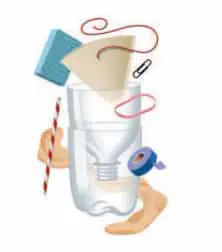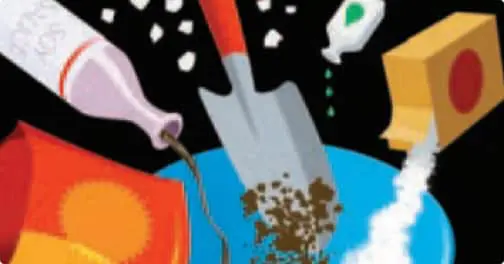Overview
STEM careers
Agricultural & Biological
Material Science
Environmental
Material Science
Environmental
Grade level
3-5
6-8
6-8
Topic
Topic title
Topic title
Topic title
Topic title
Topic title
Time
30 min or less
Materials
Per class:
|
Per team:
|
Instructions
Students discover methods of filtering water to remove as many particulates as possible. Caution: For safety, be sure to inform participants not to taste or eat any of the materials during this activity
- Fill a bucket with water and have 1 or 2 students help you create the polluted water, naming the contaminant that each addition represents.
• Food coloring = chemicals
• Raisins = animal or human waste
• Potting soil = earth
• Baking soda = road salt
• Soy sauce = motor oil
• Torn paper plate = litter - Ask each team to remove the screw cap from their 2-liter bottles and throw it away. Turn the top half of the bottle upside down and place it inside the bottom half of the bottle. The filter will be built inside the inverted top half of the bottle; the bottom half will collect the water that runs out of the filter.

- Give each team their materials and describe the challenge, which is to design the most efficient water filtration system possible, with the materials supplied. They can only use 8 items, not counting the bottle itself.
- Give teams 15 minutes to discuss, design, and construct their filter.
- Each team explains the choices they made.
- Pour the contaminated water into each filtration system. See whose water comes out the cleanest.
- Ask teams to think about what they’d do differently if they could rebuild their filtration systems, and why.
Guiding questions
- Which material will be best at getting the smallest particles out of the water?
- Which materials do you think would work better at filtering the water than the ones you’ve got for this activity?
Engineering & science connections
- A quarter of the world’s population is without safe drinking water. Providing clean water to remote villages around the world requires building effective water filtration systems that are different from the ones that make clean water come out of our taps. Engineers for a Sustainable World, Engineers without Borders, and similar organizations work on the problem of providing clean water for people around the world.
- Only about 1% of the water cleaned by the large treatment plants in North America is used for drinking. The rest is used for washing, irrigation, and industrial processes.
- This activity uses a method called physical filtration. The water runs through layers of materials that absorb and adsorb certain particles.
- The type of filtration system the students created in this experiment is similar to that used at large-scale treatment plants. Other purification tools, such as chemicals and UV light, are used to eliminate pollution and microorganisms that filtration cannot.
Water purification activity, courtesy of Craig Just, University of Iowa, is from the DVD Discover Engineering
Translated activity PDFs
Spanish
French
Italian
Explore more
Discover STEM careers
Become a volunteer
Find STEM activities

